WHAT'S NEW:
BACKGROUND:
Mission
Project Description
Cruise Plans:
Participants
Technology (ROV, ships, etc.)
Future Plans
Results:
1998 NeMO Cruise
Axial 1998 "Eruption"
Logbook
July 2, 1999
July 2, 1999
Contents:
- News from Thompson
- Participant Perspective
- Logbook from Teacher at Sea
- Question/Answer from shore to sea
Thompson Science Report
Chief Scientist's Weekly Report
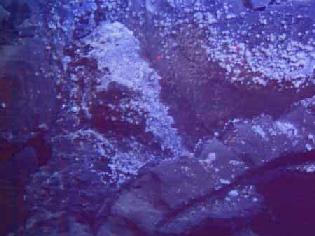
Gelatinous masses (bag creatures) at a new vent (Bag City) discovered by ROPOS dive 491. |
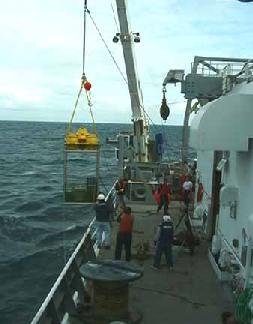 For several days, we have been waiting for the weather to calm down enough
to retrieve the elevator (photo left). Several postponements arose from
the concern that the wave surge would dislodge some of the samples and/or
instruments and they would be washed out of the elevator at the surface.
During the late afternoon, the command was sent from the surface to release
the elevator from the seafloor with its cargo of instruments and samples.
The personnel of the T. G. Thompson
did a magnificent job in recovering the package in a combined small boat
and ship recovery in less than optimal conditions.
For several days, we have been waiting for the weather to calm down enough
to retrieve the elevator (photo left). Several postponements arose from
the concern that the wave surge would dislodge some of the samples and/or
instruments and they would be washed out of the elevator at the surface.
During the late afternoon, the command was sent from the surface to release
the elevator from the seafloor with its cargo of instruments and samples.
The personnel of the T. G. Thompson
did a magnificent job in recovering the package in a combined small boat
and ship recovery in less than optimal conditions.
We have made much progress in the past week on NeMO99 with several long and very successful dives. Most of the instruments deployed last year have been recovered and many of the key samples for the various disciplines have been successfully recovered. The hydrothermal system that arose from the 1998 dike injection and eruption is still vigorous, and it appears that we will be able to continue productive studies of its chemical and biological processes well into the future.
Listing of all Science News postings
Life at Sea: Participant Perspective
Mike Perfit and John Chadwick
University of Florida
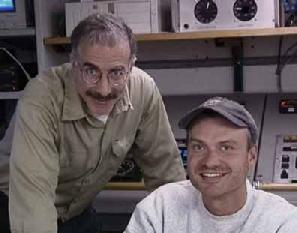 We make up the "hardrock" contingent of the expedition. We are investigating
magma genesis along the Juan de Fuca Ridge and the chemistry of lavas
that make up Axial Volcano and its adjacent rift zones. We like to
remind everyone on board that if it wasn't for the eruption of magma on
to the seafloor there wouldnt be any hydrothermal activity, mineral deposits
or bugs for them to study. So really we are the most important group of
scientists out here!!! That probably explains why they make us stay up
all night taking samples of basalt with our wax
corer when ROPOS isn't diving.
We make up the "hardrock" contingent of the expedition. We are investigating
magma genesis along the Juan de Fuca Ridge and the chemistry of lavas
that make up Axial Volcano and its adjacent rift zones. We like to
remind everyone on board that if it wasn't for the eruption of magma on
to the seafloor there wouldnt be any hydrothermal activity, mineral deposits
or bugs for them to study. So really we are the most important group of
scientists out here!!! That probably explains why they make us stay up
all night taking samples of basalt with our wax
corer when ROPOS isn't diving.
Actually, we do rely on ROPOS to recover large, well located basalt samples from the newly erupted lava as well as the older lavas that surround the new flow. We are very interested in the chemical and mineralogic components in the lava flow. Chemical analyses of the recovered samples completed back in our geochemistry labs at the University of Florida and at the US Geological Survey in Denver will tell us what the source of the magma is and if there has been a recent change in the temperature and chemical evolution of the magma chamber that underlies Axial's caldera. Because there are so many biologic and hydrochemical experiments going on during ROPOS dives, we often have to "settle" for bits of basalt that are sucked up with bacterial mats, snails and scale worms or picked up with attached tubeworms. The biologists are kind enough to give us the "slimed" samples after they have extracted their prey.
When ROPOS is not diving we use a 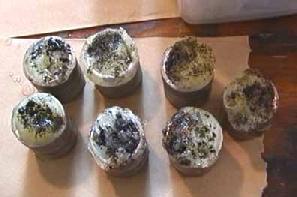 400 lb. coring device (built
by D. Fornari
at Woods Hole) to recover bits of brittle natural glass that form on the
tops of lava flows around the caldera and along the north and south rift
zones. This corer has seven pipe-like "cutters" stuffed with deep-sea
coring wax (similar to surfboard wax) that pieces of basalt glass stick
to when they are impacted by the core dropped from the ship at 60 meters
a minute. (photo left) Although we only recover a few grams of basaltic
glass this way, that is plenty of sample to analyze using modern microanalytical
techniques. So far we have had excellent success ( 97 % recovery rate)
while sampling 35 different sites along the rift zone that extends south
of Axial. We have not yet approached the
record
recovery that John had last year when the core wire wrapped around a pillow
lava and brought over 100 lbs of rock up with the corer!!. To
insure recovery this year, we had an observer travel down nearly 2000m
with the core. Honey Bear volunteered to personally oversee the coring
operation. Under great pressure, he succeeded in sampling some very difficult
parts of the seafloor.
400 lb. coring device (built
by D. Fornari
at Woods Hole) to recover bits of brittle natural glass that form on the
tops of lava flows around the caldera and along the north and south rift
zones. This corer has seven pipe-like "cutters" stuffed with deep-sea
coring wax (similar to surfboard wax) that pieces of basalt glass stick
to when they are impacted by the core dropped from the ship at 60 meters
a minute. (photo left) Although we only recover a few grams of basaltic
glass this way, that is plenty of sample to analyze using modern microanalytical
techniques. So far we have had excellent success ( 97 % recovery rate)
while sampling 35 different sites along the rift zone that extends south
of Axial. We have not yet approached the
record
recovery that John had last year when the core wire wrapped around a pillow
lava and brought over 100 lbs of rock up with the corer!!. To
insure recovery this year, we had an observer travel down nearly 2000m
with the core. Honey Bear volunteered to personally oversee the coring
operation. Under great pressure, he succeeded in sampling some very difficult
parts of the seafloor.
Mike Perfit
I am a Professor at the University of Florida (home of the "fighting Gators") and specialize in Igneous Petrology (the study of rocks that form from magma) and Marine Geology. My first cruise was to the Caribbean Sea when I was a graduate student and at that time, I was so seasick that I vowed I would never go again. But here I am again, nearly 25 years and 17 cruises later, enjoying the science, adventure and camaraderie of being at sea. I look forward to working with many scientists and students with diverse backgrounds and interests and the discoveries that come from our multidisciplinary method of studying the seafloor. I have participated on many cruises using the manned submersible ALVIN, but this is the first time I have had the opportunity to use ROPOS. Even though we work very long and sometimes erratic hours, I find it relaxing to be away from the daily confusion in my office and satisfying to be focused on one objective . I can also avoid cooking, cleaning and mowing the lawn! However, it is difficult to be away from my family for a month at a time (at least we have e-mail).
I have known Chief Scientist Bob since we were graduate students at Lamont-Doherty Geological Observatory. We have been on quite a few cruises together and I have enjoyed investigating the Galapagos Spreading Center and many portions of the Juan de Fuca Ridge with him. Bill Chadwick and I have also worked on a number of projects related to the volcanology of mid-ocean ridges. I use much of what I learn out here in my classroom lectures and impressing my friends at dinner parties. The National Science Foundation has funded my research on the Juan de Fuca Ridge and has provided financial support for my graduate students (including John). Doing research like this has been a life-long dream of mine and I am very glad to be out here on this exciting cruise.
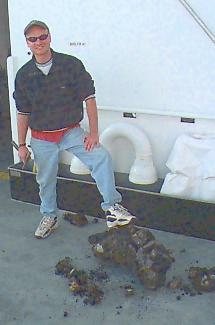 Hello. Im John Chadwick, a Ph.D. student from the
University of
Florida studying the volcanic and tectonic (faults) history of
Axial
Volcano and the neighboring
Juan de Fuca mid-ocean ridge. I'm interested
in how the chemistry of Axial's lavas have changed over time, and how the
volcano interacts with the mid-ocean ridge.
To a geologist like myself,
the little animals and bacteria that are a main focus of this expedition
into the Pacific fall into three categories:
Hello. Im John Chadwick, a Ph.D. student from the
University of
Florida studying the volcanic and tectonic (faults) history of
Axial
Volcano and the neighboring
Juan de Fuca mid-ocean ridge. I'm interested
in how the chemistry of Axial's lavas have changed over time, and how the
volcano interacts with the mid-ocean ridge.
To a geologist like myself,
the little animals and bacteria that are a main focus of this expedition
into the Pacific fall into three categories:
Its the rocks under the sticky stuff that we love to talk about. But I realized the other day that the collection of geologists, biologists, and chemists on the ship allows for a unique opportunity to interact and learn from each other. After we retrieved a large sample of basalt rock from the ocean floor on Wednesday using ROPOS (that we will use for geochemical analysis), Mike noticed that there were little worms crawling around under an upper layer of rock. The biology people came to collect these narids and bamboo worms (day- and week-old macaroni and cheese, respectively), and a discussion of what the worms might be doing there ensued. The geologists knew rock stuff, and the biologists knew worm stuff, and a better understanding of that ecosystem was reached than could have been if either group was working alone. This type of interaction happens a lot. And why not? Everything is linked out here: the hot magma that is the engine for volcanic eruptions and earthquakes also heats up the water in the rock and creates the hydrothermal vents, which in turn support the fragile and tenuous ecosystems containing the exotic life forms. Were all learning from each other out here; not just deepening our scientific understanding of our own specialties, but broadening our understanding of Axial Volcano as a whole.
Listing of all Perspectives postings
Teacher At Sea Logbook
Teacher Log #12 7/2/99
Today was definitely a day of discovery. Dive 492 was very successful for those interested in hydrothemal vents and their ecosystems. Three new vent sites were located as ROPOS traversed a southern area not yet covered in previous visits. The major goal for this dive was to determine the southern extent of the lava flow from the 1998 eruption. During the cruise in August of 1998, much of the northern portion of the lava flow had been identified. Today ROPOS explored Axials southern rift zone area believed to include part of the 1998 lava flow.
ROPOS was directed to the surface after about a 12 hour dive. The weather and seas were relatively calm so an evaluation was made as to whether we would retrieve the elevator.
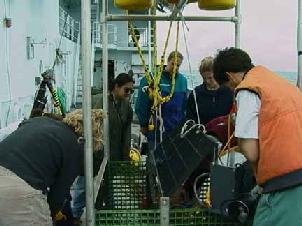 Scientists removing the samples on deck from elevator which had
been deposited into the elevator on the seafloor.
Scientists removing the samples on deck from elevator which had
been deposited into the elevator on the seafloor. |
One of the true mysteries of the Juan de Fuca vent systems is the presence of spherical blobs of a mucus like substance found at low temperature diffuse flow vent sites. These "creatures" have been found to be associated with vent sites influenced by recent eruptions, including the eruption here at Axial in 1998. Bag creatures as they are affectionately referred as, are muco-polysaccharide blobs filled with water that to this day still have scientists scratching their heads. They are not a living substance. They do not have a cellular makeup. They are most likely a microbial bi-product, but so far, we do not know who is making this substance. Research is being done to determine more about this common but unusual vent substance, but for now its one of lifes little mysteries.
Bye for now
Logbook of all Teacher At Sea postings
Questions & Answers
Questions from the HMSC Public Wing audience:
How is vent fauna nourished with
oxygen?
Vent fauna collect their oxygen just as other organism do in the
sea, they absorb if from the sea water. Oxygen dissolves into the sea
water at the surface of the water where it comes in contact with the
atmosphere.
Do hyperthermophiles (microbes that live above 100 degrees
Celsius) from the subsurface biosphere need oxygen?
Hyperthermophiles do not use oxygen. They are referred to as
anaerobes which means "without oxygen". Vent fluid must mix with deep sea
water in order to pick up dissolved oxygen
Are vent communities related to life of the photic zone?
Vent communities are unique on to themselves. Their systems do
not relate to those that use the sun as an energy source for making
organic nutrients through photosynthesis. It is still up for discussion
as to vents being a possible origin of life.
Lots more work needs to be done before this will be widely accepted.
All Questions/Answers from sea
![]() Send Your Question to NeMO
Send Your Question to NeMO
(oar.pmel.vents.webmaster@noaa.gov)